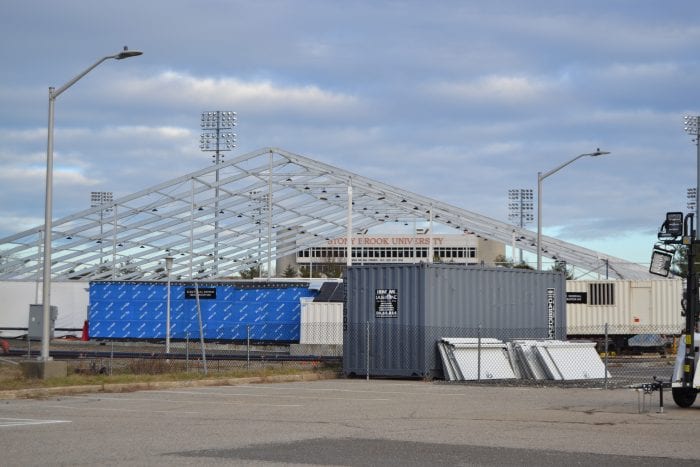Stony Brook field hospital partially dismantled

The state’s field hospital set up on the Stony Brook University grounds earlier this year has looked a little different over the past few weeks.
At the end of April, five climate-controlled structures were completed by the U. S. Army Corps of Engineers to provide SBU Hospital and other local medical centers with more beds due to the COVID-19 pandemic. Residents passing by the alternate care facility structures recently have noticed that they are roofless and the interior walls — used to create mini rooms — are now dismantled.
According to state officials, several temporary state field hospitals were prepared for the December winter storm, which included snow. Part of that prep work included emptying the structures of equipment and fixtures. At SBUH, the fabric tenting materials were also removed. However, the field hospital is not being dismantled completely in case it needs to be opened for patients. The 1,000-bed facility in Stony Brook has never been used.
According to state officials, all of the components that were removed were inventoried and are ready for use wherever needed, whether in Stony Brook, on Long Island or across the state.
The hospital extension was slated for patients with health care issues outside of COVID-19 in order to free up bed space in the hospital and other local medical centers to treat patients with the virus. The final cost for the alternate care facility was some $155 million, according to the U.S. Army Corps of Engineers. All work done by USACE for the construction of alternate care facilities was funded by Federal Emergency Management Agency mission assignments to USACE.
State Assemblyman Steve Englebright (D-Setauket) said when the alternate care facilities were assembled little was known about the pandemic’s course.
“At the time that they were built, the hospitals in Queens had so many bodies that they were tying refrigeration trucks together in the parking lots, just to store the bodies,” he said, adding the hospitals couldn’t process and bury the bodies fast enough.
“To put it in perspective, that was the environment in which the governor’s office basically made a decision,” he said. “I think they were informed by the seriousness of space limitations.”
He added early on no one knew that the infection rates would be down by the summer.
“The reality is that hindsight is 20/20,” Englebright said. “At that point in time, they did not have the benefit of knowing the scale, magnitude or speed of the pandemic. The governor was successful in suppressing New York’s acceleration in those months in the spring. And so, I think you have to look at the current dismantlement of the hospital as a testament, not of wastefulness, but of merciful success in suppressing the acceleration of the pandemic in New York.”






